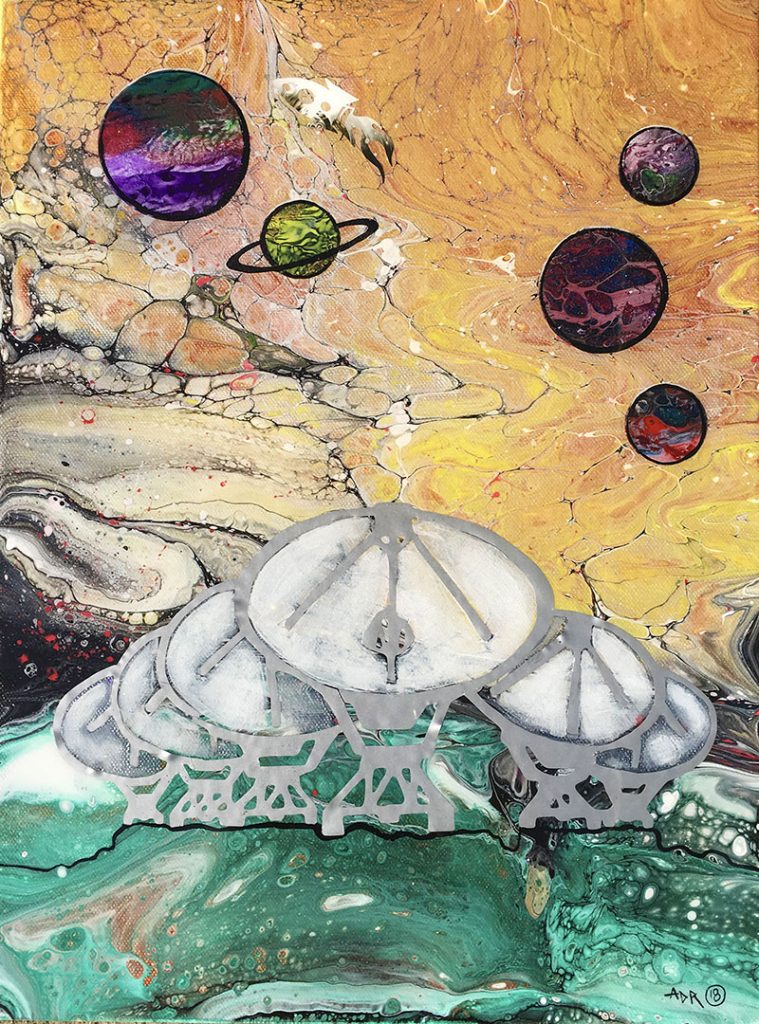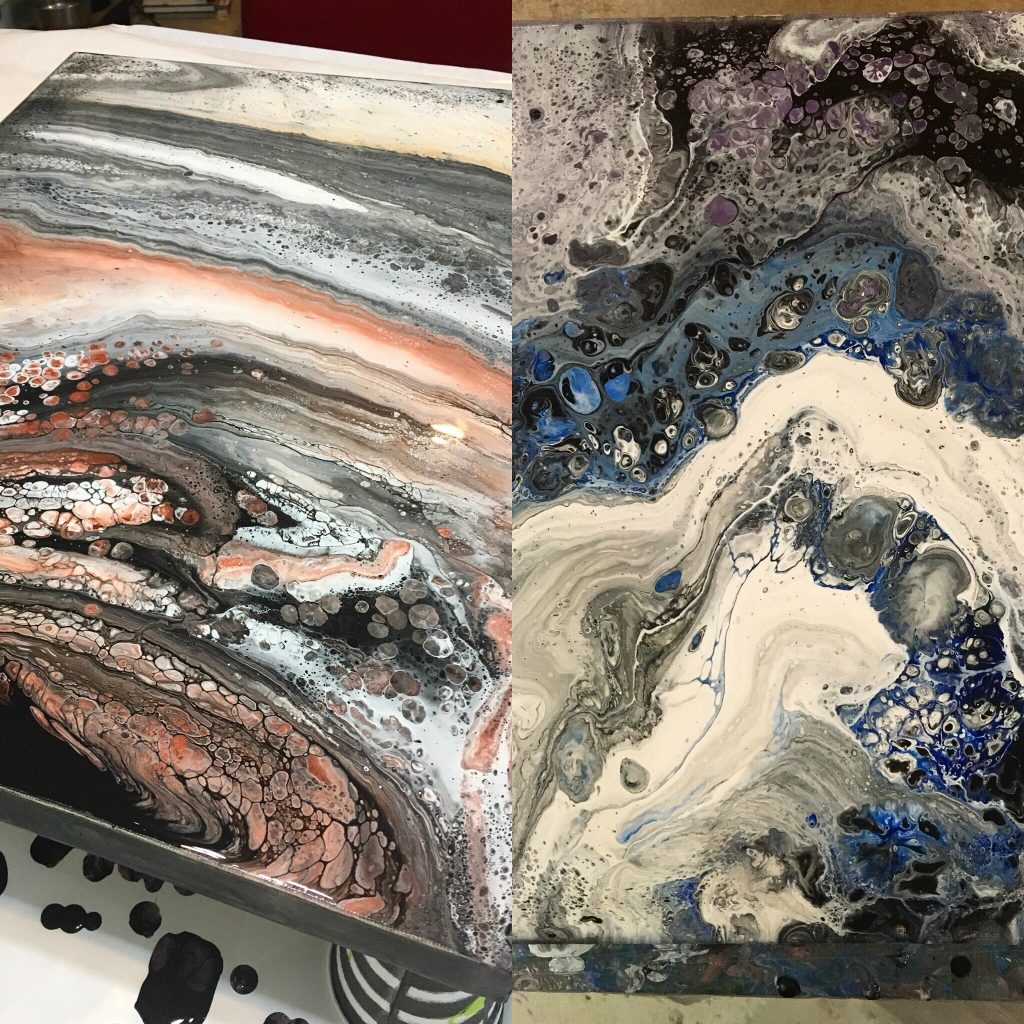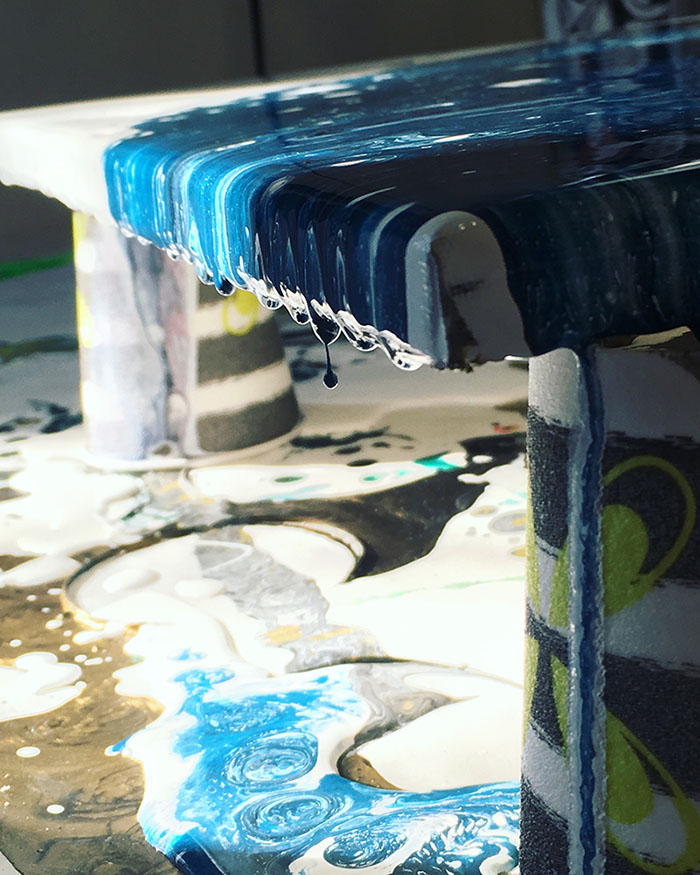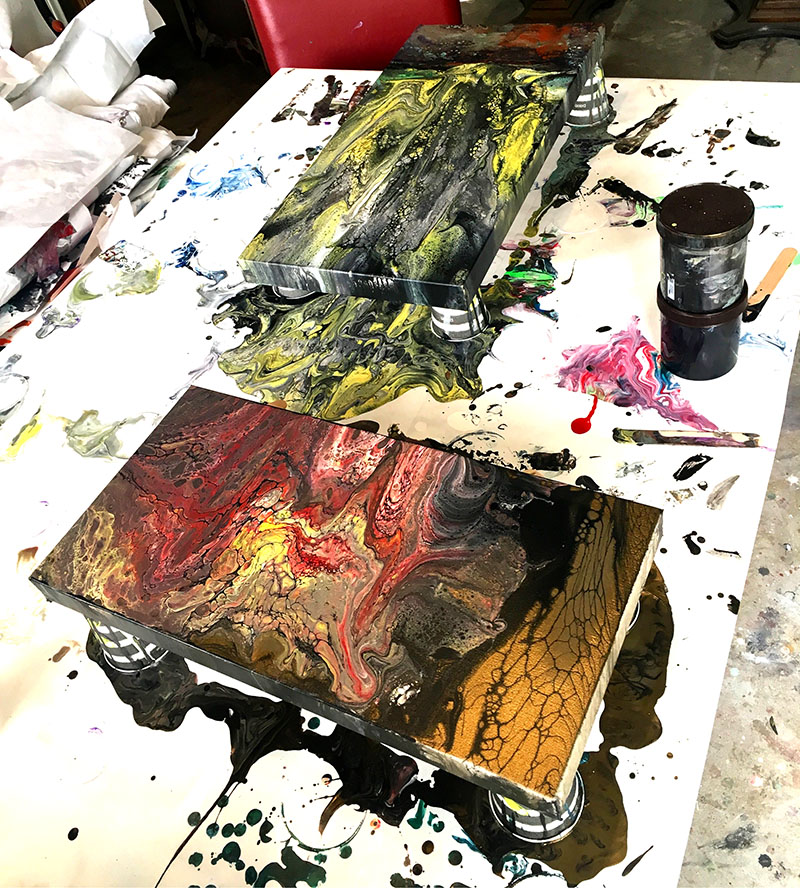
There is an art and DIY craft trend sweeping the nation called Paint Pouring or Fluid Art. You may have seen advertisements from your local art and craft store advertising super-sweet deals on “fluid mediums” perfect for paint pours. Attached to the ads are often photos of swirled or marbled looking paintings with multiple colors and bright cell-like shapes.
At first glance these paintings seem magical and highly complex. But the reason for their popularity in DIY workshops and art studios is that the complexity is easily achieved with a tiny bit of know-how and the love of making a mess. Who doesn’t love an excuse to make a beautiful mess? I love making a mess so much that during the hiatus here at Mad Art Lab, I taught myself so much about Fluid Painting that I now teach a monthly class at my art studio in Los Angeles. And I want to share what I’ve learned with you!
There is a lot of cool info about techniques and how to do this type of art on the cheap so this will be a multiple part post, but the first thing I want to share with you is the secret science of paint pouring that few people seem to know or talk much about.
People think Paint Pouring is a relatively new technique that suddenly popped up on the art scene but the truth is that it was discovered by accident in the 1930’s by a Mexican Marxist Activist and (famous) muralist by the name of, David Alfaro Siqueiros.  David was a pretty cool dude. He was very serious about being a politically engaged artist and was known to give up commissions if it jeopardized what he believed to be his educational messages to the public. That gets my respect. Power to the people! His “accidental painting’ as he called it was a bit of a footnote in his overall career but it certainly informed the artists that were exposed to his work directly, such as that guy who liked to get drunk and throw paint at the canvas, Mr Jackson Pollock.
David was a pretty cool dude. He was very serious about being a politically engaged artist and was known to give up commissions if it jeopardized what he believed to be his educational messages to the public. That gets my respect. Power to the people! His “accidental painting’ as he called it was a bit of a footnote in his overall career but it certainly informed the artists that were exposed to his work directly, such as that guy who liked to get drunk and throw paint at the canvas, Mr Jackson Pollock.
When a science friend (Thank you Aniketa.) sent me this article from Physics Central, I was enthralled. I was already doing paint pouring and this story that explains the science within the process simply thrilled me to the core! What the article explains, is that in the 1930’s when Siqueiros saw, what he described as an accidental painting he created in his studio that combined complexity and beauty with very little effort, he immediately became curious and reached out to science for help in explaining it. How could something so beautiful, seemingly form by accident? Science help us! At first science was like, “What the hell does this power-to-the-people-rable-rousing-muralist want our help for?” But lucky for us, Siqueros did not give up on his quest for answers, and finally science took note.
What was determined to be happening in these beautiful swirly accidental paintings was the natural process described by science as Fluid Dynamics! What the heck is Fluid Dynamics you ask? I asked that question too. I reached out to Science Twitter and found Gary Nave, A Ph.D. candidate in Engineering Mechanics at Virginia Tech. His research relates to fluid (air and water) forces on objects, including gliding animals and vibrating cylinders. I asked Gary for a simple explanation of Fluid Dynamics to get us started.
In fluid dynamics, we study the movement of air and water through experiments, computer simulation, and mathematical theory in any kind of situation, including jet engine propulsion, animals drinking, droplet splashes, and atmospheric flows. Because of the complex behaviors of air and water, fluid dynamics is one of the most visually beautiful sciences to study.
So what the heck does this have to do with art and Fluid Painting or Paint Pouring specifically? In an upcoming post I will teach you how to perfectly mix your paints to get them all at an even consistency so that nature and fluid dynamics can do the rest.
What happens with the many droplets and swirls is literally fluid dynamics at its most basic level. Different pigments are made of different materials and each of these materials has a specific weight and density. Some are heavier such as metals and some are from plant matter such as flowers or resins. When the pigments are all mixed with a similar fluid medium so that the pigments are similarly suspended and allowed to interact, the various pigments push and pull against each-other and some rise to the top and some sink to the bottom. Depending on viscosity and amount, they move around, sometimes mix, but most often, if left to do their thing, they rise and sink creating the appearance of cells or bursted bubbles on the canvas. If you swipe a heavier color, say titanium white, that is made with titanium, over a lighter (in weight) color such as yellow, the yellow will push its way to the surface while the white sinks around it. SO. COOL.
Once you understand the science of Fluid Painting you suddenly have a lot more control over work that was once seemingly only accidental. You can easily google the materials and weights of certain pigments within paints and then pick colors to mix and swipe that you know will rise or sink. There is always a bit of mystery as to what your final piece will look like and that is part of the joy of this technique but having an understanding of the science within the pigments can really open up more doorways to fun and experimentation in your work.
Next up, I will teach you how to mix your own paints without spending a fortune at the art store. Special thanks to Gary Nave for taking the time to talk with me. For more detailed information on the research of fluid dynamics and art please check out the links below.
Art and Physics Converge: Accidental Painting at Physics Central


Photos in post by me. If you like my work or writing please drop a buck in my tip jar below. More to come soon! Back to the art studio I go!




